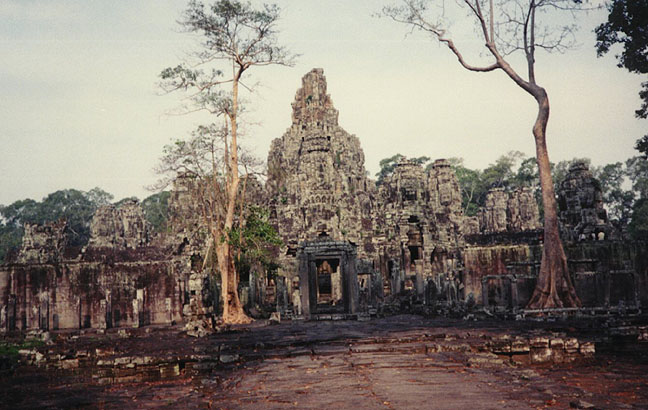

Angkor Thom

entrance

the site
Angkor Thum, royal city and Buddhist temple complex at Angkor, the region that served from 802 until 1295 as the capital of the Khmer Empire of Cambodia. Khmer king Jayavarman VII, who reigned in the late 12th and early 13th centuries, began building the vast monument at Angkor Thum (Khmer for "Angkor-the-Great" or "Great City") after he had regained control of the Angkor region from the Cham army of northern Cambodia, which had seized it around 1177.
Angkor Thum was built over and around buildings and temples built by earlier Khmer kings, but its layout was modeled on Angkor Wat, a Hindu temple complex south of Angkor Thum. Angkor Wat was finished about thirty years earlier under Khmer king Suryavarman II, who was overthrown by the Cham army. Jayavarman was a recent convert to Mahayana Buddhism, and is thought to have abandoned Hinduism as a result of the defeat of the Hindu Suryavaram II by the Chams.
Despite Angkor Thum's origins in Buddhism, it reflects the typical allegorical architectural pattern of Hindu temples, which symbolize the entire Hindu cosmology (world concept). At the center of Angkor Thum remains a stepped central temple—the Bayon—with a 45 m (148 ft) high pyramidal tower at its center.
carved heads
The tower has four massive heads carved into its top. Each head, representing both the Buddha and King Jayavarman VII as the Buddha's reincarnation, faces one of the four directions. Fifty-one smaller towers surrounded the central tower, each likewise ornamented with four carved heads facing the four directions. The two walls enclosing the Bayon were decorated with bas-relief carvings.
Bayon bas-reliefs
man on elephant
animal suckling
crocodile biting man's leg
The exterior of the outer walls included bas-reliefs depicting historical events, and the bas-reliefs on the exterior of the inner walls depicted legendary scenes. In Hindu symbolism, the central temple area represents Mount Meru—the mountain on which the Hindu gods reside and which is regarded as the center of the universe. After the death of King Jayavarman VII, the Bayon was in fact converted into a Hindu temple by Brahman priests.
profile
The structures of Angkor Thum were built of sandstone, laterite—dense, porous, iron-bearing soil that can be quarried like stone—and wood. The entire complex was surrounded by a 100 m wide moat that was used both for defense and as part of the irrigation system, which included large artificial lakes, or barays, outside of the temple complex to the east and the west. The moat symbolized the primordial ocean that according to Hindu cosmology surrounds the habitable world.
detail
Numerous causeways led over the moat to the complex. The 8 m high exterior walls of the complex formed a perfect square, two sides running east to west and two sides running north to south. In the center of each wall was an elaborate gateway and road into the complex, each leading to the gateways in the center of the exterior walls of the Bayon. A fifth gate led directly from the Royal Enclosure, just north of the Bayon, out of Angkor Thum and to the Eastern baray. The Royal Enclosure, including an official palace, living quarters, and royal gardens for the court, was originally constructed by Khmer king Suryavarman I in the first half of the 11th century.
doorway
The sculpture and bas-relief carvings that decorate the gallery walls of much of Angkor Thum appear to have once been painted and gilded. Although extensive, they are generally considered to be of inferior quality to those of Angkor Wat. The interior walls of the temple buildings themselves are devoid of ornament, although it is thought that they were once covered with murals. Because these temple buildings were built exclusively for the priests or high royalty, only a limited group of people would have ever seen the murals. The working population of peasants and craftspeople lived outside the wall of the royal city and worshipped at the temples lining the exterior galleries.
carved face
Both Angkor Thum and Angkor Wat were altered by subsequent inhabitants. Pillaged by Thai invaders in the 15th century, the complexes were extended by later rulers of Cambodia, some of whom rebuilt existing structures altogether. In the 15th century the Ângkôr area was abandoned as a political capital for reasons of security and, after the Thai invasion of 1431, was not permanently inhabited as a capital again.